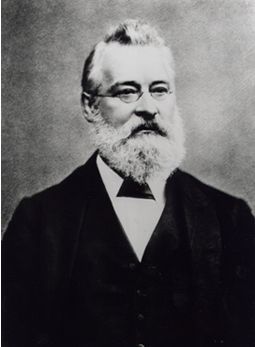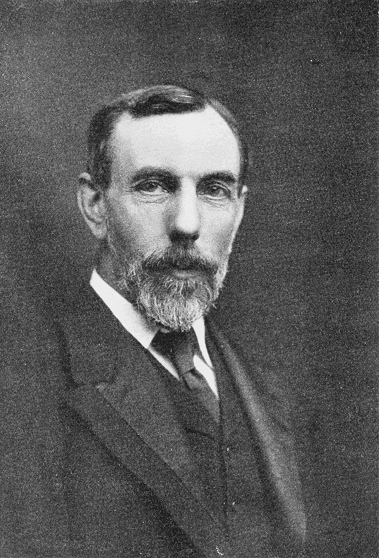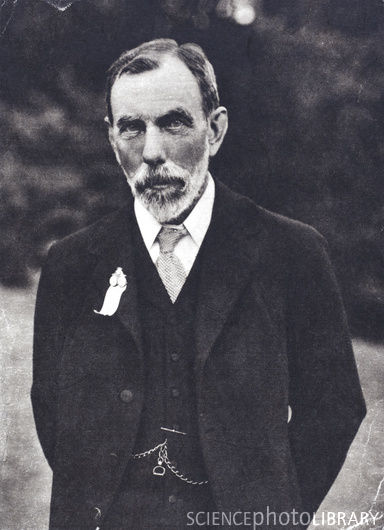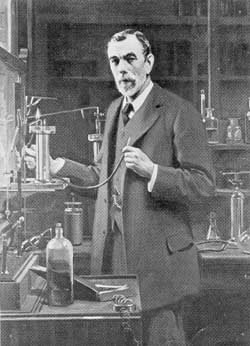<Back to Index>
- Chemist John Alexander Reina Newlands, 1837
- Chemist William Ramsay, 1852
PAGE SPONSOR

John Alexander Reina Newlands (26 November 1837 - 29 July 1898) was an English chemist who worked on the discovery of the Periodic Table.
Newlands was born in London and was the son of a scottish Presbyterian minister and his Italian wife. He was home schooled by his father rather than going to a normal school studied and went on to study at the Royal College of Chemistry but was also interested in social reform, and in 1860, he served as a volunteer with Giuseppe Garibaldi in his campaign to unify Italy. Returning to London, he set up in practice as an analytical chemist in 1864, and in 1868 became chief chemist in James Duncan's London sugar refinery, where he introduced a number of improvements in processing. Later he left the refinery and again set up as an analyst with his brother Benjamin.
Newlands was the first person to devise a Periodic Table of elements arranged in order of their relative atomic weights. Continuing Döbereiner’s work with triads and J.B. Dumas' families of similar elements, in 1865 he published his law of octaves which states that "any given element will exhibit analogues behaviour to the eighth element following it in the table". Newlands’ arrangement showed all known elements arranged in seven groups which he likened to the octaves of music. The elements are ordered by atomic weights that were known at the time. They were numbered sequentially to show the order of atomic weights. In Newlands’ table periods and groups are shown going down and across the table, respectively – the opposite from the modern periodic table.
The incompleteness of a table he drew up in 1864 alluded to the possible existence of additional, undiscovered elements. For example, he predicted the existence of germanium.
At the time, his law of octaves was ridiculed by his contemporaries and the Society of Chemists did not accept his work for publication.
In 1894, Newlands had a child by the name of Christopher Maddocks Newlands.
After Dmitri Mendeleyev and Lother Meyer received the Davy Medal from the Royal Society for their later 'discovery' of the Periodic Table, Newlands fought for recognition of his earlier work; he eventually received the Davy medal in 1887.
Newlands died on 29 July 1898 at his home in Lower Clapton, London, and was buried at West Norwood Cemetery. His business was continued after his death by his younger brother, Benjamin Edward Reina Newlands (1842 – 1912).



Sir William Ramsay KCB FRSE FRS (1852–1916) was a Scottish chemist who discovered the noble gases and received the Nobel Prize in Chemistry in 1904 "in recognition of his services in the discovery of the inert gaseous elements in air" (along with Lord Rayleigh who received the Nobel Prize in Physics that same year for the discovery of argon).
Ramsay was born in Glasgow on 2 October 1852, the son of civil engineer William Ramsay and Catherine, née Robertson. He was a nephew of the geologist Sir Andrew Ramsay.
He attended the Glasgow Academy and then continued his education at the University of Glasgow under Thomas Anderson and then went to study in Germany at the University of Tübingen with Wilhelm Rudolph Fittig where his doctoral thesis was entitled Investigations in the Toluic and Nitrotoluic Acids.
Ramsay returned to Glasgow as Anderson's assistant at the Anderson College. He was appointed Professor of Chemistry at the University College of Bristol
in 1879 and married Margaret Buchanan in 1881. In the same year he
became the Principal of University College, Bristol, and somehow managed
to combine that with active research both in organic chemistry and on gases.
In 1887 he succeeded Alexander Williamson to the chair of Chemistry at University College London (UCL). It was here at UCL that his most celebrated discoveries were made. As early as 1885 – 1890 he published several notable papers on the oxides of nitrogen developing the skills that he would need for his subsequent work.
On the evening of 19 April 1894 Ramsay attended a lecture given by Lord Rayleigh. Rayleigh had noticed a discrepancy between the density of nitrogen made by chemical synthesis and nitrogen isolated from the air by removal of the other known components. After a short discussion he and Ramsay decided to follow this up. By August, Ramsay could write to Rayleigh to announce that he had isolated a heavy component of air, previously unknown, which did not appear to have any obvious chemical reactivity. He named the gas "argon". In the years that followed, working with Morris Travers, he discovered neon, krypton, and xenon. He also isolated helium which had been observed in the spectrum of the sun but had not been found on earth. In 1910 he also made and characterized radon.
In 1904 Ramsay received the Nobel Prize in Chemistry. Ramsay's high standing in scientific circles led to him being an adviser in the setting up of the Indian Institute of Science. He suggested Bangalore as the most appropriate location for the institute.
Ramsay’s high standing in scientific circles led to his unfortunate
endorsement in 1905 of the Industrial and Engineering Trust Ltd., a
corporation with a supposed secret process to extract gold from seawater.
The corporation bought property along the English coast to implement
the gold - from - seawater process, but the company quickly faded from
public view, and never produced any gold.
Ramsay was married to Margaret Johnstone Marshall (née Buchanan, daughter of George Stenenson Buchanan) and had a daughter, Catherine Elizabeth (Elska) and a son, William George, who died at 40.
Ramsay lived at Hazlemere, Buckinghamshire until his death. He died at High Wycombe, Buckinghamshire, on 23 July 1916 from nasal cancer at the age of 63 and was buried at Hazelmere Parish church.
A blue plaque at number 12 Arundel Gardens, Notting Hill, commemorates his life and work.